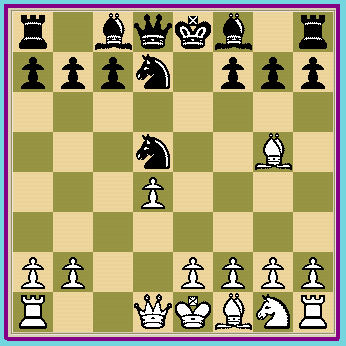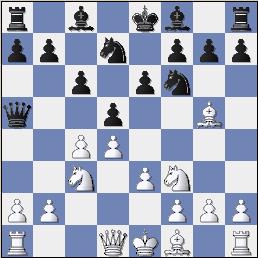Its
probably a bad idea to nominate yourself for an award, but I may as well go
ahead and do it. This may be the finest and most thorough job of annotating a
chess game anywhere on the Internet. If you know of a better job ... one where
the author was at least a Master and spent perhaps 2000 hours (or more) working
on the game ... be sure to let me know!! Otherwise, until I see proof of a
better job, than I nominate this game as:
The
Best Annotated Chess Game on the Internet!
Jose
R. Capablanca (2775)
- Alexander A. Alekhine (2745)
[D52]
World
Championship Match in Buenos Aires,
Argentina. (Game # 11), 1927.
[ Annotators = J. R. Capablanca
& A.J. Goldsby I ]
***
(This
is a game that I did rather recently (1999-2000) for the
floridachess magazine.
Three GM's,
and many other Masters,
(over a dozen!); have written or e-mailed me to tell me
that this is
one of the finest jobs of game annotation that they had ever seen.
***
I
have made quite a few changes to the
game since it was published.
***
I have also endeavored to add many diagrams, in the hope that
you can follow this game without a chess board. If you would
like a copy of this game, whether it be a print-out, chess-base
format, or whatever; please contact
me.)
***
This
is a Model Game. [Copyright
(c), A.J.C.E; Inc. 2000, (c) 2001.]
One of the best games from the 1927 match between ...
Jose R. Capablanca and Dr.
Alexander A. Alekhine.
This match was for the chess championship of the world.
This is game Number Eleven, (# 11.); of that match.
Also one of the greatest
all-time World Championship Match games.
Many notes based on
Capa's own ideas.
See
"The World Championship Matches,
1921 &
1927."
by J.R. Capablanca. [Dover Books]
***
Note:
This game has the incorrect move score in ALL
the
[electronic] databases I could find. I had to get the correct
move score out
of the books! {A.J.G.}
(I
document this carefully and in its entirety in the course of this game.)
***
This
game started when my friend, Mike
Thornton,
sent me an e-mail
stating that Capablanca had missed an easy win. He was also
the first
to point out that the computer saw a mate in three in a
position that is
actually a mate in one! I worked on this game for many weeks.
(Originally, I had just wanted to prove
to Mike - and myself! - that Capa
had NOT missed such an easy mate. My
research has also found
dozens of examples of classic games in computer
databases
that have the
incorrect score!)
Eventually, not wanting
all that work to be wasted, I sent the
game into the Florida (State) Chess
Magazine for publication.
(It was published there just a few months later.)
Now I have decided to place the game on one of my
websites, for my fans' and friends' enjoyment. (And all chess lovers everywhere!)
It took approximately 200, (That's well over TWO HUNDRED!!!); hours of work to make
this web-page ready for publication in my website. I hope you appreciate the
amount of work that it took.
***
(Click HERE to see a very detailed explanation of the amount
of time that
was involved in bringing you this web page.)
***
I also have had to modify the symbols slightly, as
FrontPage
(and HTML) does not recognize most of the
regular
symbols used in annotating chess games.
(Informant-style symbols that mean "White is better,"
"Unclear," etc.)
The normal symbol that "White is a little better," or,
"A plus over an equal," is instead rendered as "+/=".
(Just think of the normal symbols, but turned
on its side, like the smiley face.) {
:) }
***
I
have also tried to color-code the variations, (and use spacing);
instead of ChessBase's {format} style, which features an endless
use of
parenthesis. (I think you should be able to follow the game
quite easily
now. The lay-out is now ...
pretty clear and straight-forward. At least, I hope so!)
***
The
main line is Black in color.
***
And
all the Diagrams of the actual game
are given with
a very thick border.
***
This should make them fairly easy to recognize and make it
easy to tell the difference between the positions from the actual
game and diagrams from the analysis. Also, sections of the analysis
will be separated from other sections by bold,
blue asterisks.
(In fact,
ANY [bold] asterisk is a divider!)
***
I
arrived at the above ratings by taking each players'
"ELO, 5 Year-Peak." (The best five-year average for each player.)
Then I added 50 points to account for rating inflation. I know this
is correct, because several mathematicians told me that there
has been at
least 100 points of inflation
since FIDE adopted
the ELO rating system. (1960's.)
***
(If
you look at the players today, I think you will understand
are accurate -
perhaps even UNDERVALUED!!
I don't really
believe that Garry Kasparov is 200
points stronger than
Alekhine at his peak!!!)
***
You
don't need a chess set to follow the game.
There are diagrams every few moves.
However, for the analysis of the opening variations and some
of the more
complicated lines, a chess set is (highly) recommended.
***
I
have used standard abbreviations for the opening manuals.
I.e., MCO-14 stands
for "Modern Chess Openings," (14)
by GM Nick DeFirmian
and Walter Korn.
***
I
had this page completely fail (crash or become unusable) a number
of times. After
wasting over 200 hours of work, I have decided to split
this page into MANY
DIFFERENT PAGES. This was the only way I could
see completing this
page and not have it become unstable in FrontPage.
***
I
have also tried to make the individual pages stand by themselves.
This included giving the complete game score at the top of each page.
In this way, you could study each page one at-a-time.
(If you were so inclined.)
***
This
is one of Alekhine's greatest games.
(Click HERE
to see one of Capablanca's greatest games. Or HERE.)
Would
you like to see this game on a java-script "replay" board?
Maybe you
would like to open two separate windows, and
follow the game on the js board?
Well now you can!
Click here to
see this entire game
on a "java-script replay board." Do it now!
The game begins with the double-QP, a
virtual requirement
of the best players during that era. It also reflects that the
Classical School of Thought was still predominant, and
that the ideas of 'Hypermodernists' had yet to be fully embraced.
***
1. d4 d5; 2. c4 e6;

3. Nc3 Nf6; 4. Bg5 Nbd7;

(Actual game position after 4...Nbd7.)
5. e3,

The simplest, guarding the pawn at c4. White
nails the
d4-square, and guards the pawn on c4 with his King Bishop.
***
[ A cute trap every QP
player should know is:
5. cxd5, exd5; 6. Nxd5??, Nxd5!;
***
(Black wins a key pawn. The move looks like a
hallucination,
as it appears that Black has dropped his Queen.)

(Analysis Diagram.
The position after 6...Nxd5.)
***
(Black wins a key pawn. The move looks like a
hallucination,
as it appears that Black has dropped his Queen.)
***
7. Bxd8 (?) Bb4+;
The point. Black
will regain is Queen with interest.
8. Qd2[] {box, or only move}
8...Kxd8; 9. Rc1, Bxd2+; 10. Kxd2, f5; "-/+". ]
***
(Returning to the actual game, now.)
5...c6; 6. Nf3 Qa5!?; ('!')

(Black just played 6...Qa5.)
***
This is the,
"Cambridge Springs Defense."
It is named after one of the very few International
Tournaments played in the U.S. prior to 1950.
(Cambridge
Springs, 1904.)
(The variation is so named because it was first introduced by
Harry N. Pillsbury
and played for the first time at that tournament.)
This
variation was all the rage during the 1920's and 30's.
It was used in several
World Championship matches. Then it disappeared from top-level chess and was not
seen for nearly 60 years. {A.J.G.}
***
I also propose that
this variation be referred to as the,
"Pillsbury
Variation" after its creator. {A.J.G.}
|
The Encyclopedia of Chess Openings (ECO)
classifies this opening variant under D52.
Here are the major variations:
Normal Queen's Gambit Declined; Classical Variation
1.d4 d5; 2.c4 e6; 3.Nc3 Nf6; 4.Bg5 Nbd7; 5.e3 c6; 6.Nf3
Cambridge Springs Defense, Proper
1.d4 d5; 2.c4 e6; 3.Nc3 Nf6; 4.Bg5 Nbd7; 5.e3 c6; 6.Nf3 Qa5;
Queen's Gambit Declined/C.S.D; Bogoljubow Variation
1.d4 d5; 2.c4 e6; 3.Nc3 Nf6; 4.Bg5 Nbd7; 5.e3 c6; 6.Nf3 Qa5; 7.Nd2 Bb4;
8.Qc2
Q.G.D./C.S.D; Argentine Variation
1.d4 d5; 2.c4 e6; 3.Nc3 Nf6; 4.Bg5 Nbd7; 5.e3 c6; 6.Nf3 Qa5;
7.Nd2 Bb4; 8.Qc2 O-O; 9.Bh4.
Q.G.D./C.S.D; Rubinstein Variation
1.d4 d5; 2.c4 e6; 3.Nc3 Nf6; 4.Bg5 Nbd7; 5.e3 c6; 6.Nf3 Qa5; 7.Nd2 dxc4;
Q.G.D./C.S.D; Capablanca Variation
1.d4 d5; 2.c4 e6; 3.Nc3 Nf6; 4.Bg5 Nbd7; 5.e3 c6; 6.Nf3 Qa5; 7.Bxf6.
Q.G.D./C.S.D; with 7.cxd5 [Exchange Variation]
1.d4 d5; 2.c4 e6; 3.Nc3 Nf6; 4.Bg5 Nbd7; 5.e3 c6; 6.Nf3 Qa5; 7.cxd5.
Q.G.D./C.S.D; Yugoslav Variation
1.d4 d5; 2.c4 e6; 3.Nc3 Nf6; 4.Bg5 Nbd7; 5.e3 c6; 6.Nf3 Qa5; 7.cxd5
Nxd5;
Source: CompuServe Chess Forum & LM A.J.
Goldsby I
Thanks to Steve Etzel for compiling this
info.
Click HERE
(forrmerly here)
to go to his web-site on
Cambridge-Springs, 1904. |
***
7. Nd2,

(Actual game position after 7. Nd2.)
***
This move, 7. Nd2
is the main line here.
***
But it is by no
means the only move here.
White can also play
7. cxd5 and 7. Bh4,
among other possible moves here.
***
Hit the
"NEXT" button below to go to the following page of this game.
Copyright (c) {LM} A.J. Goldsby I
Copyright (c) A.J. Goldsby, 1995-2008.
Copyright © A.J. Goldsby, 2009. All rights
reserved.
  

This
game was previewed over 100 times by many different people.)
| 